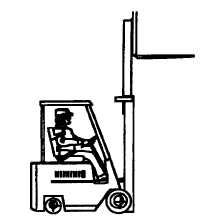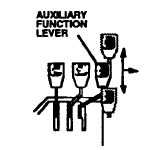| |
TM 10-3930-671-24
Lift Mechanism & Controls
Be sure there is adequate overhead clearance before
raising the upright or damage to equipment, or injury
could result.
NOTE
It is recommended that these tests be conducted with a
rated capacity load, if possible.
1.
Cycle (raise to full height and then lower) the
upright at both slow and fast speed, with the rails
tilted slightly backwards. Watch the upright
assembly as it rises.
a)
All
movements
of
the
upright,
fork
carriage, and lift chains must be even and
smooth, without binding or jerking motion.
b)
Watch for chain wobble or looseness; the
chains should have equal tension and
move smoothly without noticeable wobble.
2.
Check for correct function of the lift control lever
and main hydraulic valve. Listen for abnormal
noise in the hydraulic valve, main hydraulic
pump, and system components.
3.
If the maximum fork height is not reached, this
indicates there is an inadequate (low) oil level in
the hydraulic sump tank, severe binding within
the upright, or chains are too long.
4.
Observe the upright assembly: rails, rollers,
carriage, lift chains, and cylinders as they move.
a)
The fork carriage should move smoothly
when raised or lowered from any height
position.
b)
Check for binding or excessive free-play
(looseness) between the carriage and the
upright rails and rollers.
c)
Check for proper sequencing.
d)
Listen for abnormal noises.
e)
If there is excessive clearance between
the rails and channels, the need for upright
roller adjustment is indicated.
f)
If the rails or carriage bind or hesitate
when
lowering,
this
indicates
either
damaged
rollers
or
incorrect
roller
adjustment.
5.
Check the upright for excessive downdrift. Stop
the fork carriage in an intermediate position.
Observe whether it holds its position or slowly
drifts downward. If the fork carriage does not
hold its position when stopped, the upright may
have too much downdrift due to wear of the
cylinder seals. Conduct an upright cylinder
downdrift test, with rated load, as needed.
Refer to Section 2.1, Service Specifications.
6.
Test the tilt control. Check for excessive tilt
cylinder drift.
Refer to Section 2. 1, Service Specifications and Section
10. 7, Tilt Cylinder Maintenance.
7.
Test the correct tilt cylinder rod adjustment
(upright racking). Check tilt cylinder rod-to-rod
end
engagement:
must
have
minimum
engagement equal to rod diameter.
8.
Check for correct fork height adjustment.
Auxiliary Function Control
If lift truck is equipped with an optional attachment, an
additional control lever will be mounted to the right of the
tilt control lever. The lever must be pushed to the right
before moving it forward and back to operate the
attachment, or auxiliary function. Check the control for
correct function by briefly operating the attachment.
Push Forward To:
Pull Back To:
• Lower
• Raise
• Tilt Forward
• Tilt Backward
• Rotate to Left
• Rotate to Right
• Side Shift to Left
• Side Shift to Right
• Open Clamp
• Close Clamp
• Extend Push-Pull
• Retract Push-Pull
F-48
|





